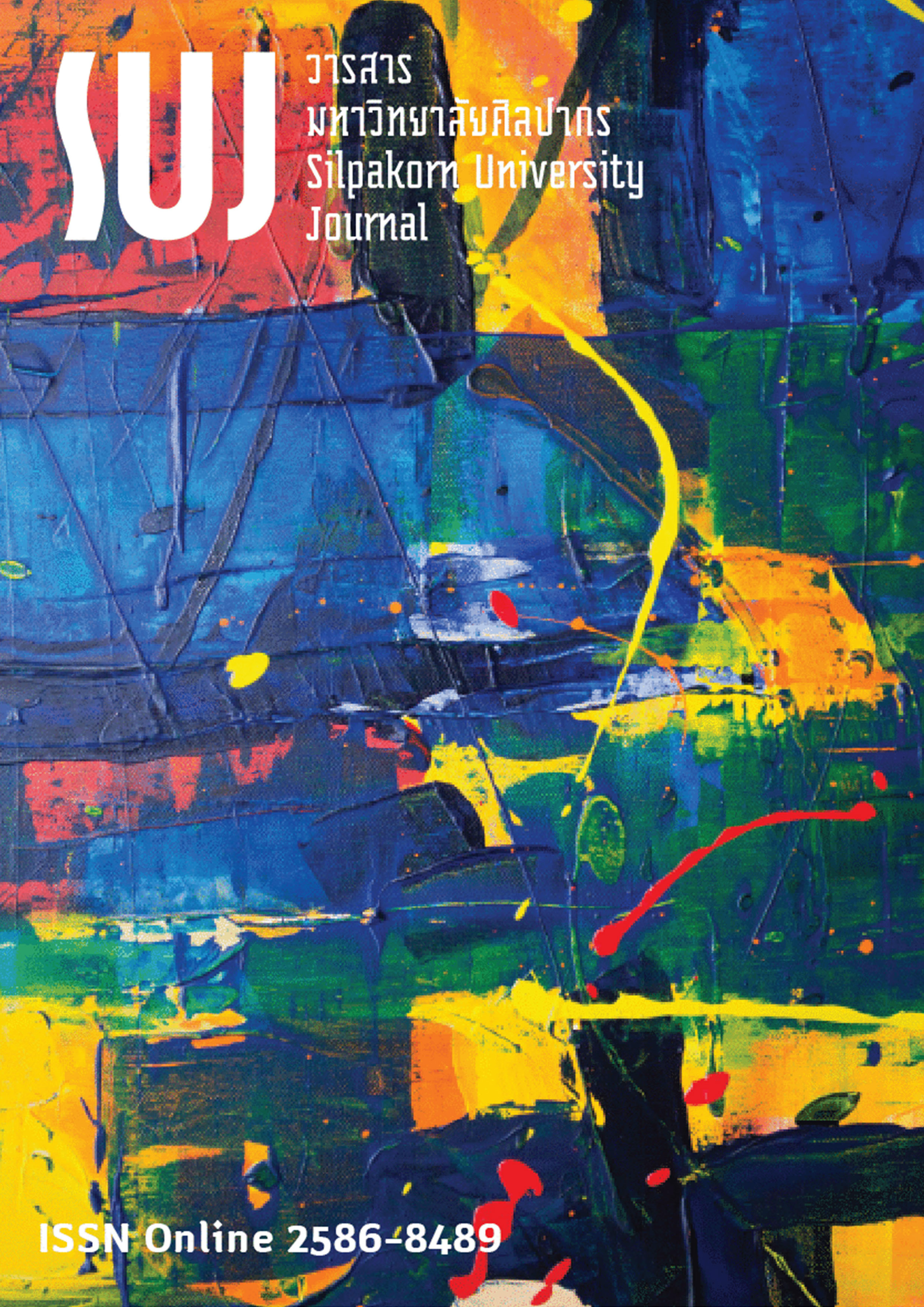ความรุนแรงและความตายในแฟนตาซีกับการขัดเกลาเยาวชน: กรณีศึกษานวนิยายเยาวชนชุด การิน ปริศนาคดีอาถรรพ์ (Violence and death in fantasy fiction and a way to instill self-control in young adults: The case study of a young adult fiction series Karin Pritsana Khadi Athan)
Main Article Content
Abstract
บทความนี้ศึกษาบทบาทของแฟนตาซีที่ประกอบด้วยความรุนแรงและความตายในนวนิยายเยาวชนชุดการิน ปริศนาคดีอาถรรพ์ ซึ่งแต่งโดย อัยย์ โดยเลือกตอน “ความลับของกระจกเงา” เป็นข้อมูลหลักในการวิเคราะห์ การศึกษาพบว่า “ความลับของกระจกเงา” มีวัตถุประสงค์ที่จะปลูกฝังเยาวชนผู้อ่านให้รู้จักควบคุมตนเอง มิให้ดำเนินชีวิตตามความปรารถนาส่วนตนมากจนเกินไป เพราะอาจสร้างปัญหาและความเดือดร้อนให้กับทั้งตนเองและสังคม นักเขียนสร้างแฟนตาซีที่มีลักษณะโหดร้ายรุนแรงและเกี่ยวเนื่องกับความตาย เพื่อแสดงให้เห็นอันตรายของการดำเนินชีวิตตามความปรารถนาส่วนตนได้อย่างชัดเจน ประสบการณ์อันน่าสะพรึงกลัวที่ตัวละครหลักได้รับเปรียบได้กับบทลงโทษของการละเมิดกติกาของสังคม แฟนตาซีจึงมีบทบาทเป็นเครื่องมือในการขัดเกลาตัวละครให้เกิดความสำนึกและให้โอกาสแก่ตัวละครอีกครั้ง ในการพิสูจน์ตนเองในฐานะเยาวชนที่ผ่านการขัดเกลาแล้ว และยินดีที่จะประพฤติตนตามกติกาของสังคม ความรุนแรงและความตายในแฟนตาซีจึงมีความสำคัญต่อการปลูกฝังคุณลักษณะที่พึงประสงค์ เพื่อสร้างเยาวชนต้นแบบแก่ผู้อ่าน ทั้งนี้ หวังเป็นอย่างยิ่งว่า การศึกษาประเด็นดังกล่าวจะเป็นประโยชน์ต่อการศึกษาความรุนแรงและความตายในวรรณกรรมเยาวชนแนวแฟนตาซีของไทย เพื่อทบทวนและสร้างความเข้าใจเกี่ยวกับความรุนแรงและความตายอันเป็นลักษณะไม่พึงประสงค์ในขนบประพันธ์วรรณกรรมเยาวชนของไทย
This article studies the role of fantasy fiction through the young adult fiction The Secret of the Mirror, which is the fourth episode of the series KARIN PRITSANA KHADI ATHAN written by Ai. The study found that The Secret of the Mirror aims to instill self-control in young adults. The story proposes reasons why young adults should not let their lives being exceedingly overwhelmed by their personal desires. The story shows that doing so can cause problems and harm to oneself and the society. The novel is imbued with brutality and violence which leads to the matter of life and death. This is viewed as the writer’s intentions to emphasize the danger of one living life without self-control but allowing their lives to be led by desires. Terrifying experiences that the main character encounters constitute the punishment from their violating social norms. In this case, fantasy fiction is deployed as a tool to illustrate disadvantages of excessive desire. Also, the main character who is a young adult has a second chance to prove himself as a person, who has been educated and finally agrees to follow the norms of society. Violence and death in fantasy fiction is, therefore, very important to instill desirable characteristics in young adults. Moreover, the novel provides a role model for readers. Moreover, It is hopeful that this research has contributions to further study about violence and death in Thai fantasy fiction for young adults. This is to review and gain an understanding about violence and death which are the undesirable tradition in writing Thai young adult literature for.
Downloads
Article Details

This work is licensed under a Creative Commons Attribution-NonCommercial-NoDerivatives 4.0 International License.
References
Ai. (2008). Karin Pritsana Khadi Athan Young Adult Fiction Series, The Life Channing Ritual Episode (การิน ปริศนาคดีอาถรรพ์ ตอนพิธีกรรมเปลี่ยนชีพ). Bangkok: Punica Plublishing.
Ai. (2009). Karin Pritsana Khadi Athan Young Adult Fiction Series, The Secret of the Mirror Episode (การิน ปริศนาคดีอาถรรพ์ ตอนความลับของกระจกเงา). Bangkok: Punica Plublishing.
Ai. (2010). Karin Pritsana Khadi Athan Young Adult Fiction Series, Happy Deathday Episode (การิน ปริศนาคดีอาถรรพ์ ตอนสุขสันต์วันถึงฆาต). Bangkok: Punica Plublishing.
Chimpleewat, Thammajak. (2012). The Superstition in Karin Pritsana Khadi Athan Young Adult Fiction Series (ไสยศาสตร์ที่ปรากฏในนวนิยายชุดการิน ปริศนาคดีอาถรรพ์). Bachelor’s dissertation, Silpakorn University, Nakhon Pathom, Thailand.
Duangwiset, Naruephon. (2017). Sex in the Maze: Sex Theory in Consumer Culture (เพศในเขาวงกต: แนวคิดทฤษฎีเพศในวัฒนธรรมบริโภค). Bangkok: Princess Maha Chakri Sirindhorn Anthropology Centre.
Hutinta, Areeya. (2019). Half – Asleep She’s Revived, Half – Awake She’s lost: the Dissolving World of Aomkaew Kalyanapong (ครึ่งหลับเธอฟื้น ครึ่งตื่นเธอสูญเสีย: โลกที่กำลังสูญสลายของอ้อมแก้ว กัลป์ยาณพงศ์). In Phasasan Wannakamsan: Articles on the Occasion of the 50th Aniversary of Department of Thai, Faculty of Arts, Silpakorn University (ภาษาสารวรรณกรรมสารเนื่องในวาระ 50 ปี ภาควิชาภาษาไทย คณะอักษรศาสตร์ มหาวิทยาลัยศิลปากร), (pp. 309-324). Nakhon Pathom: Faculty of Arts, Silpakorn University.
Jackson, R. (1981). Fantasy: The Literature of Subversion. London: Methuen.
Jantharat, Supitchaya. (2018). The Technic of Fantasy Novel Creation: Case Study of KalYanee Suksasunee (กลวิธีการแต่งนวนิยายแฟนตาซี กรณีศึกษากัลยาณี สุขษาณี). Master’s dissertation, Rangsit University, Pathum Thani, Thailand.
Kumpiree, Supasinee. (2014). The Inheritance of Thai Traditional Literatures and Tales in Thai Young’s Literatures That Were Plublished in Year 2002 to 2011 (การสืบทอดวรรณคดีและนิทานในวรรณกรรมเยาวชนไทยช่วงปี พ.ศ. 2545 - พ.ศ. 2554). Master’s dissertation, Silpakorn University, Nakhon Pathom, Thailand.
Lasongyang, Phattharakhan. (2018). Think Write Create Tales and Books for Children (คิด เขียน สร้าง นิทานและหนังสือสำหรับเด็ก). Bangkok: Chulalongkorn University Press.
Linitda, Arrisa. (2017). The Fantasy Literary Series “SAVENA: The City of Magic”: an Analysis of the Plot and the Presentation Techniques of the Plot (วรรณกรรมแฟนตาซีชุดเซวีน่า มหานครแห่งมนตรา: การวิเคราะห์โครงเรื่องและกลวิธีการนำเสนอโครงเรื่อง). Master’s dissertation, Naresuan University, Pitsanulok, Thailand.
Mahawarakon, Suphak. (2009). Metaphor of Water and the Path of Nirvana in Jatakatthakatha (ความเปรียบเกี่ยวกับน้ำกับมรรคาสู่นิพพานในอรรถกถาชาดก). Master’s dissertation, Chulalongkorn University, Bangkok, Thailand.
Manit, Phiriyadit. (2013). Psychoanalysis Words for Literary Criticism (ศัพท์จิตวิเคราะห์สำหรับวรรณคดีวิจารณ์). Bangkok: Faculty of Arts, Chulalongkorn University.
Office of the National Economic and Social Development Council. (2006). The National Economic and Social Development Plan The 10th Plan 2007-2011 (แผนพัฒนาเศรษฐกิจและสังคมแห่งชาติ ฉบับที่ 10 ปี 2550-2554). (2006). [Online]. Retrieved June 6, 2021 from https://www.nesdc.go.th/ewt_news.php?nid=5747&filename=develop_issue
Phutthathatphikkhu. (1984). The Experiment of Buddhist Literary Criticism Pomkhueng (บททดลองเสนอว่าด้วยจิตวิเคราะห์แบบพุทธปมเขื่อง). Bangkok: Saysongsueksit.
Ratanakul, Suriya. (2012). Religious Rituals Part 2 (พิธีกรรมในศาสนา ภาค 2) (2nd ed.). Nakhon Pathom: Mahidol University.
Santasombat, Yot. (1999). Freud and the Development of Literary Criticism: From Dream to Social Theory (ฟรอยด์และพัฒนาการของจิตวิเคราะห์: จากความฝันสู่ทฤษฎีสังคม) (3rd ed.). Bangkok: Thammasat University Press.
Sutchaphan, Ruenruethai. (2017). Read Gen Z Literatures (อ่านวรรณกรรม Gen Z). Bangkok: Saengdaw.
Sutthisan, Usa. (2016). Adolescent Psychology (จิตวิทยาวัยรุ่น). Bangkok: Samlada.
Thirajaroensakul, Kopphon. (2014). Elements of Fantasy in the Presentation of Family and Environmental Problems in Tony Diterlizzi and Holly Black’s The Spiderwick Chronicles (องค์ประกอบของแฟนตาซีในการนำเสนอปัญหาครอบครัวและปัญหาสิ่งแวดล้อมในนวนิยาย ชุด เดอะ สไปเดอร์วิกโครนิเคิลส์ ของ โทนี ดิเตอร์ลิซซิ และฮอลลี แบล็ก). Master’s dissertation, Chulalongkorn University, Bangkok, Thailand.
Wannakit, Nittaya. (2016). Children’s Literature (วรรณกรรมสำหรับเด็ก). Nonthaburi: Inthanin.


